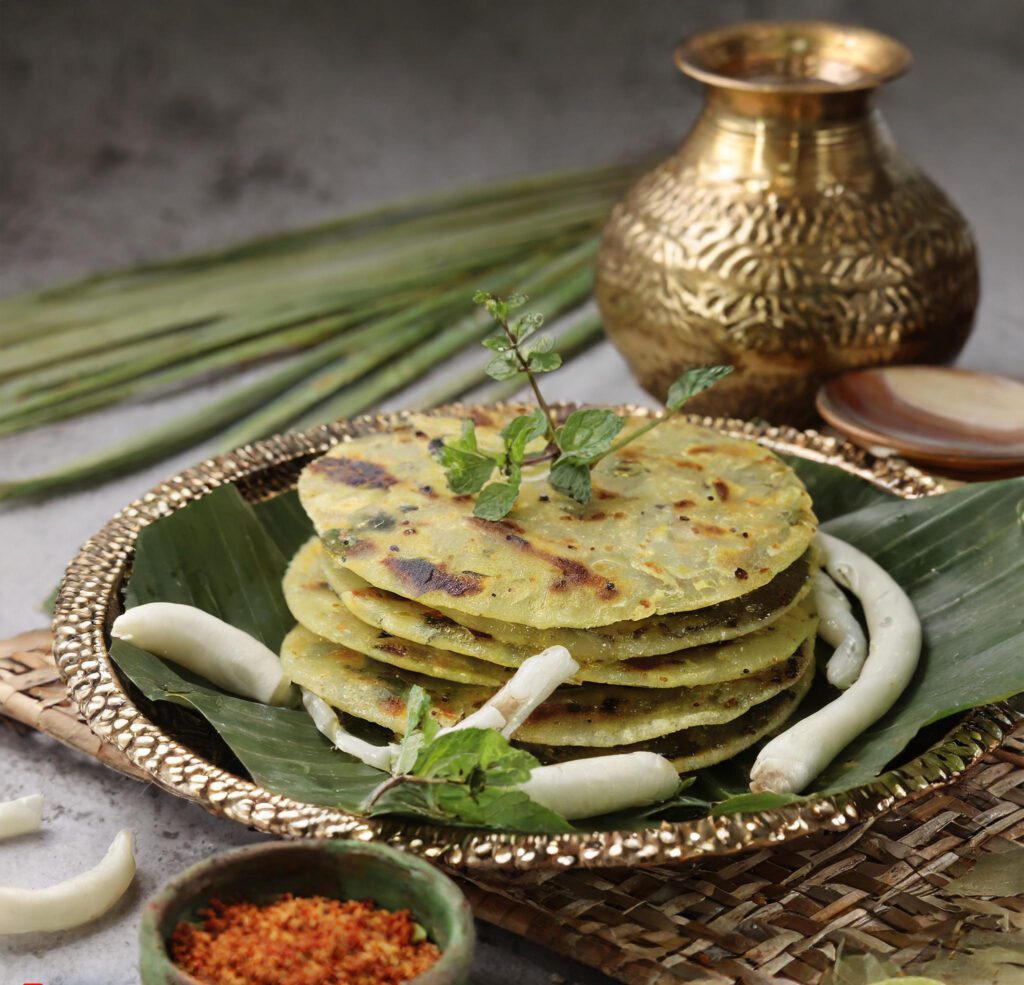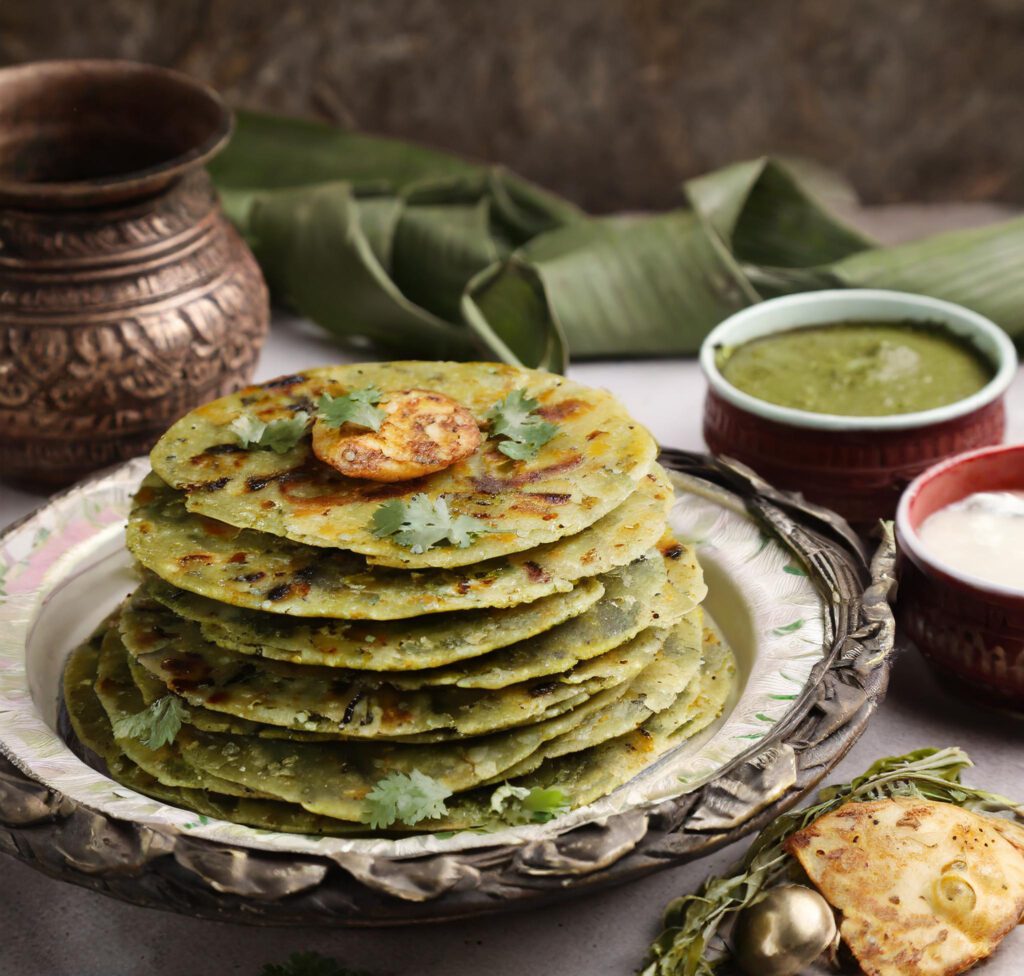Thalipeeth is a classic Maharashtrian flatbread that is both delicious and nutritious. This delectable dish is created with a variety of grains and spices, making it a nutritious and satisfying supper alternative. In this Thalipeeth Recipe, we will delve into Thalipeeth’s rich culinary legacy, discuss its nutritional benefits, and present a full Thalipeeth Recipe for recreating this traditional dish in your own home.
Understanding Thalipeeth, a Culinary Tradition
Thalipeeth is a traditional cuisine from the state of Maharashtra in western India, where it is eaten as a breakfast, snack, or main course. The term “Thalipeeth” comes from the Marathi words “Thali” meaning plate and “Peeth” meaning flour, implying that it is traditionally served as a flatbread on a plate. Thalipeeth differs from other Indian flatbreads in that it uses a unique blend of ingredients, which frequently include grains and spices.Let us begin with Thalipeeth Recipe.
Thalipeeth Recipe

Ingredients for Thalipeeth Recipe:
1 cup multigrain flour (a combination of wheat flour, rice flour, besan, and jowar flour)
1/2 cup finely chopped onions
1/4 cup finely chopped fresh coriander leaves
2-3 green chilies, finely chopped
1/4 teaspoon turmeric powder
1/2 teaspoon cumin seeds
1/2 teaspoon ajwain (carom seeds)
Salt to taste
Water, as needed
Ghee or oil for cooking
Step by Step Guide:
Step 1: Prepare the Dough
In a large mixing bowl, combine the multigrain flour, chopped onions, coriander leaves, green chilies, turmeric powder, cumin seeds, ajwain, and salt. Mix thoroughly to mix all of the ingredients.
Step 2: Knead into a Dough
Gradually add water to the flour mixture and knead it into a soft and smooth dough. The dough should be firm enough to hold its shape but not too dry or too wet. Cover the dough and let it sit for 10-15 minutes to allow the flavours to combine.
Step 3: Shape the Thalipeeth
Divide the dough into small lemon-sized balls. Flatten a ball of dough using your palms to create a little disc. Place the disc on a clean, oiled surface or a sheet of parchment paper.
Step 4: Cook the Thalipeeth
Heat a tawa or griddle over medium heat and grease it with ghee or oil. Carefully place the shaped Thalipeeth on the heated tawa and cook on both sides till golden brown and crispy. Drizzle ghee or oil along the sides to ensure uniform cooking.
Step 5: Serve Hot
Once cooked, remove the Thalipeeth from the tawa and serve it hot with fresh yogurt, pickle, or any chutney of your choice. This healthful and delicious flatbread makes a great breakfast or snack.

1. Cultural significance: Thalipeeth is a traditional flatbread from Maharashtra, India’s western state. It has cultural importance and is frequently served during festivals, celebrations, and special events. It is also a staple food among Maharashtrian households, served as a nutritious breakfast or snack.
2. Nutritional Profile::Thalipeeth is a nutritious blend of wheat, rice, chickpea (besan), and sorghum (jowar) flours. These grains are rich in dietary fiber, vitamins, minerals, and proteins, making Thalipeeth a wholesome meal option. Furthermore, the use of onions, green chilies, and fresh coriander increases its nutritious worth.
3. Traditional Preparation Methods: Thalipeeth is traditionally prepared by mixing the flour with chopped onions, green chilies, fresh coriander, spices like turmeric, cumin seeds, and ajwain (carom seeds), and water to form a dough. The dough is then formed into small discs and grilled on a hot griddle or tawa with a sprinkle of ghee or oil until golden and crispy.
4. Variations and Additions: While the basic Thalipeeth recipe remains consistent, there are variations in ingredients and regional preferences. Some variations include incorporating grated vegetables such as carrots, spinach, or fenugreek leaves into the dough for extra flavour and nutrition. Some people prefer to add sesame seeds or crushed peanuts for a crunchier texture.
5. Health advantages: Thalipeeth is a nutritious alternative with a blend of whole grains and spices, providing several health advantages. The high fibre content improves digestion, controls blood sugar levels, and promotes general gut health. It is also a fantastic source of energy, allowing you to feel full and content for longer durations.
6. Serving Suggestions: Thalipeeth is typically served hot with fresh yogurt, pickle, or chutney. It can also be served with a dollop of butter or ghee for extra flavour. Some people serve it with a side of fresh veggies or lentil curry for a complete dinner.
Thalipeeth is a delicious and nutritious flatbread that reflects Maharashtra’s rich culinary tradition while also providing health advantages. Thalipeeth, whether served for breakfast or as a snack, will tantalise your taste buds while also nourishing your body.
Thalipeeth is more than just a flatbread; it celebrates Maharashtrian culinary tradition and demonstrates the inventiveness of Indian cuisine. Thalipeeth, which incorporates a mix of grains and spices, provides a nutritious and delectable meal alternative that will satisfy your taste buds while also nourishing your body by this Thalipeeth Recipe.
So, why not begin on a culinary trip and discover the thrill of preparing and eating this traditional Indian dish? Your taste senses and health will both benefit from it by this Thalipeeth Recipe.
You can also try some Quick and Delicious Pasta Recipe: 30-Minute Pasta Recipes for Busy Nights.
Pingback: Methi Recipes: The Nutrient-Packed Fenugreek Leaves 2024